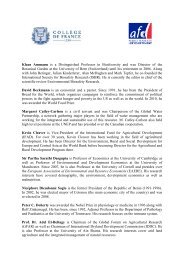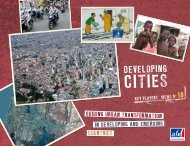Paris School of Economics - L'Agence Française de Développement
Paris School of Economics - L'Agence Française de Développement
Paris School of Economics - L'Agence Française de Développement
You also want an ePaper? Increase the reach of your titles
YUMPU automatically turns print PDFs into web optimized ePapers that Google loves.
epi<strong>de</strong>mic, life expectancy rose more rapidly in<br />
poor countries than in rich countries, so that<br />
“full” income inequality <strong>de</strong>clined faster than<br />
income inequality, though this was reversed<br />
with the dramatic reductions in life expectancy<br />
in the AIDS affected countries.<br />
There are a number <strong>of</strong> problems with these<br />
calculations. To assume that African lives are<br />
worth less than American or European lives<br />
simply because they consume less adds insult<br />
to injury. Not only do you get less than I do,<br />
but because <strong>of</strong> that, you yourself are worth<br />
less than I am; there is more to life than consumption,<br />
and people are not cattle being fed<br />
for non-cattle related ends. Beyond that — if<br />
more is in<strong>de</strong>ed nee<strong>de</strong>d — life expectancy,<br />
which may seem innocuous, also contains an<br />
implicit aggregation that is problematic. Life<br />
expectancy is an aggregate <strong>of</strong> age-specific<br />
mortality rates, but it is one specific aggregate<br />
among many possible aggregations. In particular,<br />
the increase in life expectancy in poor<br />
countries has largely been driven by <strong>de</strong>clines<br />
in infant and child mortality, whereas the<br />
increase in rich countries has come from<br />
<strong>de</strong>clines in adult mortality, particularly from<br />
<strong>de</strong>clines in mortality from cardiovascular disease<br />
and lung cancer. Life expectancy gives<br />
very high weight to lives saved at the beginning<br />
<strong>of</strong> life, and relatively little to saving the<br />
lives <strong>of</strong> 50-year-olds. While there is no agreement<br />
on which should be weighted more<br />
highly, it is far from clear that the life-expectancy<br />
weighting is the right one to choose.<br />
Reductions in the mortality rates for very<br />
young children are, at least to some extent,<br />
later accompanied by compensating reductions<br />
in fertility by parents. If so, the age structure<br />
<strong>of</strong> the population may not change very<br />
much in response to the reduction in mortality,<br />
with children who would have died soon<br />
after birth “replaced” by fewer children ever<br />
being born. There is a clear welfare gain to the<br />
parents who do not have to live through the<br />
<strong>de</strong>aths <strong>of</strong> their young children, and to women<br />
who have gone through fewer pregnancies,<br />
but those gains are hardly measured by life<br />
expectancy. If there is anything to this argument,<br />
the narrowing <strong>of</strong> the life expectancy<br />
gap between rich and poor countries from<br />
1950 into the 1980s is not a good measure <strong>of</strong><br />
<strong>de</strong>cline in inequality.<br />
If the relationship between income and health<br />
were sufficiently strong, we might not need<br />
to consi<strong>de</strong>r both, but make do with one, and<br />
let the other look after itself. Perhaps either<br />
GDP per capita or life expectancy can serve<br />
as an in<strong>de</strong>x <strong>of</strong> <strong>de</strong>velopment? This argument<br />
appears in a number <strong>of</strong> forms. One is what<br />
might be called “income fundamentalism”,<br />
that if countries experience sufficient economic<br />
growth, then health will look after<br />
itself, perhaps the best statement <strong>of</strong> which is<br />
Pritchett and Summers (1996). Another recent<br />
argument comes in a paper by Young (2010),<br />
who correctly notes that the data on growth<br />
and GDP from Africa are highly unreliable,<br />
so that we actually know very little about<br />
growth in Africa over recent <strong>de</strong>ca<strong>de</strong>s. But<br />
there have been substantial improvements in<br />
other indicators, including health and mortality<br />
<strong>of</strong> children, from which Young infers that<br />
African growth has been much higher than is<br />
shown by their national income statistics.<br />
One weakness in both <strong>of</strong> these arguments is<br />
that the correlation between growth and<br />
health improvement is very far from perfect,<br />
and that the divergence between the two is<br />
<strong>of</strong> consi<strong>de</strong>rable interest in its own right, so<br />
that we lose a great <strong>de</strong>al by ignoring it, or by<br />
treating it as entirely measurement error.<br />
The international relationship between life<br />
December 2011 / Measure for Measure / How Well Do We Measure Development? / © AFD [ 47<br />
]

















